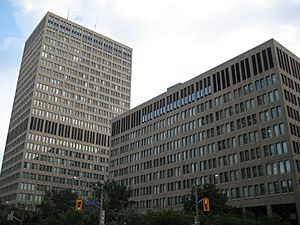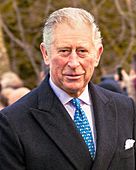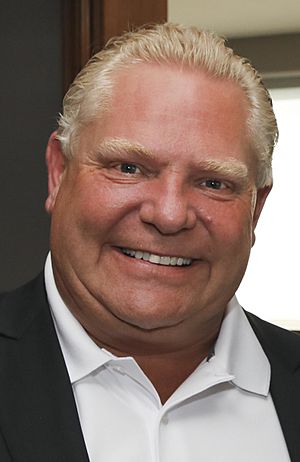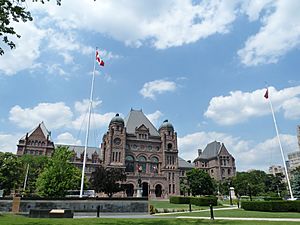Government of Ontario facts for kids
| Constitutional monarchy | |
 Coat of arms of Ontario, used across the government (left); and the Ontario wordmark, used to corporately identify the executive (right) |
|
| Formation | 1 July 1867 |
|---|---|
| Founding document | Constitution Act, 1867 |
| Country | Canada |
| Crown | |
| Sovereign | Monarch (King Charles III) |
| Vice-regal representative | Lieutenant Governor (Elizabeth Dowdeswell) |
| Legislative (Crown-in-Parliament) |
|
| Legislature | Provincial Parliament (Legislative Assembly) |
| Meeting place | Ontario Legislative Building, Queen's Park |
| Executive (Crown-in-Council) |
|
| Head of government | Premier (Doug Ford, Jr.) |
| Main organ | Executive Council of Ontario (Cabinet) |
| Judicial (Crown-on-the-Bench) |
|
| Court | Court of Appeal for Ontario (highest court) |
The Government of Ontario (French: Gouvernement de l'Ontario) is the group that runs the Canadian province of Ontario. It is a constitutional monarchy, which means it has a King or Queen as its head. In Ontario, the King is represented by the Lieutenant Governor. This system has three main parts: the executive, the legislature, and the courts. Each part has specific jobs to do. The rules for how the government works are partly written in the Constitution Act, 1867.
The term Government of Ontario often refers to the executive branch. This includes the ministers (also called the Cabinet) who are chosen by the Premier. It also includes the many public servants who work in government offices. They help carry out policies and provide services. The government officially calls itself His Majesty's Government of Ontario (French: Gouvernement de l’Ontario de Sa Majesté).
Because the main government building is at Queen's Park in Toronto, people often call the Ontario government "Queen's Park."
Contents
The Crown: Ontario's Head of State
King Charles III is the King of Canada and also the King of Ontario. Canada is a Commonwealth realm, meaning it shares its monarch with 14 other independent countries. In Canada, the King has powers for the federal government and for each of the 10 provinces.
- Crown in Ontario
-
Charles III is King of Canada, the head of state
Lieutenant Governor: The King's Representative
The King's powers in Ontario are carried out by the Lieutenant Governor. The Premier and the Cabinet usually tell the Lieutenant Governor what to do. This is because the Constitution Act, 1867 says that executive power must be used "by and with the Advice of the Executive Council."
What the Lieutenant Governor Does
The Governor General appoints the Lieutenant Governor. This appointment happens on the advice of the Prime Minister of Canada. The Lieutenant Governor then gives royal assent to new laws. This means they officially approve laws passed by the Legislative Assembly.
Usually, the Lieutenant Governor follows the advice of the Premier and Cabinet. But sometimes, they can refuse advice. This might happen if the Premier does not have the support of the elected Legislative Assembly.
For example, in 2017, after an election in British Columbia, the Premier asked the Lieutenant Governor to dissolve the Legislature. The Lieutenant Governor said no. The Premier then resigned, and another leader who had enough support was asked to form the government.
Executive Power: Running the Government
The executive power belongs to the Crown. It is used "in-Council," meaning with the advice of the Executive Council. This group is usually the Cabinet, led by the Premier. The term Government of Ontario refers to the work done by the Lieutenant Governor and the Cabinet. Government departments and agencies, staffed by public servants, carry out the daily operations.
Premier: Head of Ontario's Government
The Premier of Ontario is the most important minister of the Crown. The Premier leads the government for the province. They choose who will be in the Cabinet and lead its meetings. The Premier also advises the Lieutenant Governor on how to use executive power. Premiers are usually elected members of Provincial Parliament (MPPs). They lead the party with the most seats in the Legislative Assembly. Once sworn in, the Premier stays in office until they resign or are removed. This can happen if they lose a motion of no confidence or a general election.
In Canada, the Cabinet of provincial governments is called an Executive Council (French: Conseil exécutif).
The current premier of Ontario is Doug Ford of the Progressive Conservatives. He became Premier after the 2018 election. He is the 26th Premier since Confederation.
Cabinet Members: Ministers and Their Roles

The Cabinet is made up of ministers who lead different government departments, called ministries. Each minister is responsible for a specific area, like education, health, or finance.
| Ministry | Minister |
|---|---|
| Cabinet Office | Doug Ford (Premier) |
| Cabinet Office | Sylvia Jones (Deputy Premier) |
| Ministry of Agriculture, Food and Rural Affairs | Lisa Thompson |
| Ministry of the Attorney General | Doug Downey (Attorney General) |
| Ministry of Children, Community and Social Services | Merrilee Fullerton |
| Ministry of Children, Community and Social Services | Charmaine Williams (Associate Minister of Women's Social and Economic Opportunity) |
| Ministry of Citizenship and Multiculturalism | Michael Ford |
| Ministry of Colleges and Universities | Jill Dunlop |
| Ministry of Economic Development, Job Creation and Trade | Vic Fedeli |
| Ministry of Education | Stephen Lecce |
| Ministry of Energy | Todd Smith |
| Ministry of the Environment, Conservation and Parks | David Piccini |
| Ministry of Finance | Peter Bethlenfalvy |
| Ministry of Francophone Affairs | Caroline Mulroney |
| Ministry of Health | Sylvia Jones |
| Ministry of Health | Michael Tibollo (Associate Minister of Mental Health and Addictions) |
| Ministry of Indigenous Affairs | Greg Rickford |
| Ministry of Infrastructure | Kinga Surma |
| Ministry of Intergovernmental Affairs | Doug Ford |
| Ministry of Labour, Immigration, Training and Skills Development | Monte McNaughton |
| Ministry of Legislative Affairs | Paul Calandra |
| Ministry of Long-Term Care | Paul Calandra |
| Ministry of Mines | George Pirie |
| Ministry of Municipal Affairs and Housing | Steve Clark |
| Ministry of Municipal Affairs and Housing | Michael Parsa (Associate Minister of Housing) |
| Ministry of Natural Resources and Forestry | Graydon Smith |
| Ministry of Northern Development | Greg Rickford |
| Ministry of Public and Business Service Delivery | Kaleed Rasheed |
| Ministry of Red Tape Reduction | Parm Gill |
| Ministry of Seniors and Accessibility | Raymond Cho |
| Ministry of the Solicitor General | Michael Kerzner (Solicitor General) |
| Ministry of Tourism, Culture and Sport | Neil Lumsden |
| Ministry of Transportation | Caroline Mulroney |
| Ministry of Transportation | Stan Cho (Associate Minister) |
| Treasury Board | Prabmeet Sarkaria (President of the Treasury Board) |
Legislative Power: Making Laws
Ontario's law-making body is called the Provincial Parliament of Ontario. It has 124 members. The Legislative Assembly and the Crown (represented by the Lieutenant Governor) work together to make laws. The Lieutenant Governor's job is to give royal assent to bills. This makes them official laws after the Assembly has passed them.
Members of Provincial Parliament (MPPs)
People who work in the Legislative Assembly are called Members of Provincial Parliament, or MPPs. They are chosen by voters using a system called "first-past-the-post." This means the candidate with the most votes in each area wins.
How Government is Formed
The Legislative Assembly is important for choosing who forms the government. The Premier and Cabinet stay in power as long as they have the support of the Assembly. Most Cabinet ministers are elected MPPs. They are responsible to the Legislative Assembly for their actions.
The Official Opposition
The party with the second-largest number of seats in the Assembly is called the Official Opposition. They usually have members who act as "critics" for each government minister. Their job is to question the government's work and offer different ideas.
The Official Opposition is formally called His Majesty's Loyal Opposition. This name shows that even though they oppose the government's policies, they are still loyal to Canada and the King.
Judiciary: Interpreting Laws
- Further information: Court system of Canada
The judiciary is the system of courts that interprets and applies the laws.
| Court | Type | How Judges are Chosen | Notes |
|---|---|---|---|
| Court of Appeal for Ontario | Appellate court (hears appeals from lower courts) | Chosen by the federal government | You can appeal decisions from here to the Supreme Court of Canada |
| Court of Ontario
|
Trial court (hears cases for the first time)
|
Superior Court judges chosen by the federal government.
Court of Justice judges chosen by the province. |
The Court of Ontario includes both the Superior Court of Justice and the Court of Justice. |
| Provincial boards, commissions and tribunals | Tribunal (specialized bodies that make decisions) | Chosen by the province | Examples include the Ontario Human Rights Tribunal and the Landlord and Tenant Board. |
See Also
- Association of Management, Administrative and Professional Crown Employees of Ontario
- Cabinet of Ontario
- Ontario Public Service Employees Union
- Politics of Ontario
- Caucus services bureau





